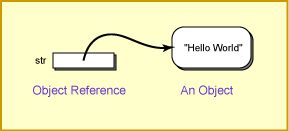Review of Object References

An object exists only after it has been constructed. Objects are constructed only as a program is running, when an object constructor is invoked.
Once it has been constructed,
an object is accessed by going through a reference to it.
Often, the reference is held in a reference variable such as str.
In the
the following example, a reference variable is declared,
and then an object is constructed.
A reference to the object is then put in the reference variable:
String str; // declare a reference variable
str = "Hello World" ; // construct the object and
// save its reference
Of course, it is OK to declare an object reference variable and not place a reference in it (it might only sometimes be needed.) And it is OK to use the same reference variable for different objects at different times:
String str; str = "Hello World" ; . . . . str = "Good-by" ;